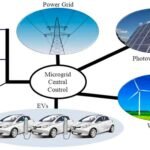What Is Smart Grid EV Charging? A Utility-Scale Overview Now

EVs & the Smart Grid — A Powerful Partnership
As electric vehicles surge in popularity, power utilities are evolving. Enter smart grid EV charging — a sophisticated system that powers your car and helps stabilize the energy grid, lowers emissions, and reduces your electricity bill.
Let’s break down what smart grid EV charging is, how it works at the utility scale, and why it’s a key piece of the 2025 energy puzzle.

What is Smart Grid EV Charging?
Smart grid EV charging refers to dynamic, data-driven charging systems that communicate with the electricity grid to:
- Balance load demand
- Optimize energy use during off-peak hours
- Incorporate renewable energy sources
- Enable vehicle-to-grid (V2G) feedback
It’s not just charging — it’s charging with intelligence.
How It Works (Simplified)
- Charger + EV + Grid = A Smart Triangle
- Charging sessions are scheduled or throttled based on:
- Grid demand
- Electricity rates
- Renewable energy availability
- With V2G, EVs can send power back to the grid during peak demand.
Why Utilities Love It
- Reduces stress on aging infrastructure
- Avoids blackouts by balancing loads
- Helps meet renewable integration goals
- Incentivizes demand response participation by EV owners
Example: During a heatwave, your EV might delay charging until 2 AM to prevent grid overload.

Key Technologies Behind Smart Charging
- OpenADR (Automated Demand Response)
- OCPP (Open Charge Point Protocol)
- Smart Meters
- EVSE Load Management Software
These tools enable seamless communication between utilities, chargers, and EVs.
Real-World Use Cases in 2025
- California & New York: Mandating V2G capabilities in new EV charger installations
- Europe: Grid-integrated EV fleets supporting wind energy stability
- Australia: Time-of-use pricing linked to EV apps
How It Saves Drivers Money
- Time-of-use rates reward off-peak charging
- Smart chargers automate cheapest energy usage
- Incentive programs (like PG&E’s EV Smart Charging Pilot) offer cash back for grid-friendly behavior
Smart Grid vs Regular Charging: What’s the Difference?
| Feature | Regular Charging | Smart Grid Charging |
|---|---|---|
| Fixed charging time | ✅ Yes | ❌ No |
| Dynamic pricing | ❌ No | ✅ Yes |
| Grid feedback (V2G) | ❌ No | ✅ Yes |
| Utility communication | ❌ None | ✅ Real-time coordination |
FAQ
Q: Do I need a special EV for smart charging?
Most 2023+ EVs support it with software updates and compatible chargers.
Q: Is smart charging mandatory?
No — it’s optional, but incentivized by many utilities.
Q: Will my EV battery wear out faster with V2G?
Slightly, but manufacturers are improving battery cycles for V2G use cases.

Final Thoughts
Smart grid EV charging isn’t the future — it’s already here. For drivers, it means lower costs and greener power. For utilities, it means grid stability and innovation.
📘 Related reads:
- What is Ad-Supported EV Charging & Is It Sustainable?
- How Energy Companies Are Shaping EV Infrastructure
- How Much Does It Really Cost to Charge an EV?
Subscribe to VoltDriveHub for tech-focused EV content and infrastructure news.




































































































































































































